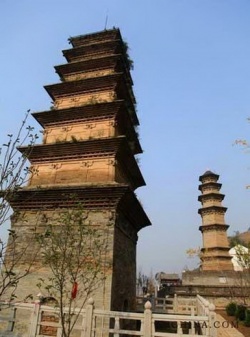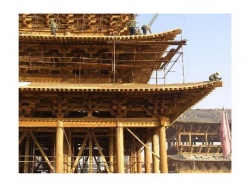Pagoda
Pagoda is a name sometimes used for Buddhist or Hindu temples or for Buddhist stūpas. The word is not derived from any language spoken in the Buddhist world nor is it used there. It is the Portuguese pronunciation of the Persian but-kadah meaning ‘idol house.’
A pagoda is the general term in the English Language for a tiered tower, built in the traditions originating in historic East Asia or with respect to those traditions, with multiple eaves common in Nepal, India, China, Japan, Korea, Vietnam, Burma and other parts of Asia. Some pagodas are used as Taoist houses of worship. Most pagodas were built to have a religious function, most commonly Buddhist, and were often located in or near temples. This term may refer to other religious structures in some countries. In Vietnam and Cambodia, due to French translation, the English term pagoda is a more generic term referring to a place of worship, although pagoda is not an accurate word to describe a Buddhist temple. The modern pagoda is an Evolution of the Ancient Nepal Stupa, a tomb-like structure where sacred relics could be kept safe and venerated. The architectural structure of the Stupa has spread across Asia, taking on many diverse forms as details specific to different regions are incorporated into the overall design.
Terms
The word is first attested for in English in the period c. 1625–35; introduced from the Portuguese pagode, temple, from the Persian butkada (but idol + kada temple, dwelling.) Another etymology, found in many English Language dictionaries, is modern English pagoda from Portuguese (via Dravidian), from Sanskrit bhagavati, feminine of bhagavatt "blessed" < bhaga "good fortune." History Panel might have originally adorned a Buddhist structure, perhaps a pagoda somewhere in northernmost China. The Walters Art Museum.
The origin of the pagoda can be traced to the Stupa (3rd century BC). The Stupa, a dome shaped monument, was used as a commemorative monument associated with storing sacred relics. The Stupa emerged as a distinctive style of newari architecture and was adopted in Southeast and East Asia, where it became prominent as a Buddhist monument used for enshrining sacred relics. In East Asia, the architecture of Chinese towers and Chinese pavilions blended into pagoda architecture, eventually also spreading to Southeast Asia. The pagoda's original purpose was to house relics and sacred writings. This purpose was popularized due to the efforts of Buddhist missionaries, pilgrims, rulers, and ordinary devotees to seek out, distribute, and extol Buddhist relics.
Symbolism
Chinese iconography is noticeable in Chinese pagoda as well as other East Asian pagoda architectures. The image of the Shakyamuni Buddha in the abhaya mudra is also noticeable in some Pagodas. Buddhist iconography can be observed throughout the pagoda symbolism.
In an article on Buddhist elements in Han Art, Wu Hung suggests that in these tombs, Buddhist iconography was so well incorporated into native Chinese traditions that a unique system of symbolism had been developed.
Architecture
Pagodas attract lightning strikes because of their height. Many pagodas have a decorated finial at the top of the structure, and when made of metal, this finial, sometimes referred to as a "demon-arrester", can function as a lightning rod. Pagodas traditionally have an odd number of levels, a notable exception being the eighteenth century pagoda "folly" designed by Sir William Chambers at Kew Gardens in London.
Some notable pagodas
Tiered towers with multiple eaves:
Songyue Pagoda on Mount Song, Henan, China, built in 523.
Palsangjeon, a five story pagoda at Beopjusa, Korea built in 553
Miruksa Temple Pagoda at Iksan, Korea, built in the early 7th century.
Xumi Pagoda at Zhengding, Hebei, China, built in 636.
Daqin Pagoda in China, built in 640.
Hwangnyongsa Wooden nine-story pagoda on Hwangnyongsa, Gyeongju, Korea, built in 645.
Giant Wild Goose Pagoda, built in Xi'an, China in 652
Pagoda at Hōryū-ji, Ikaruga, Nara, Japan, built in 7th century.
Small Wild Goose Pagoda, built in Xi'an, China in 709.
Seokgatap on Bulguksa, Gyeongju, Korea, built in 751.
Dabotap on Bulguksa, Gyeongju, Korea, built in 751.
Huqiu Tower, built in 961 outside of Suzhou, China
Lingxiao Pagoda at Zhengding, Hebei, China, built in 1045.
[[Iron Pagoda)] of Kaifeng, built in 1049 AD, during the Song Dynasty.
Liaodi Pagoda of Dingzhou, built in 1055 AD during the Song Dynasty
Pagoda of Fugong Temple, built in 1056 in Ying County, Shanxi, China.
Pizhi Pagoda of Lingyan Temple, Shandong, China, 11th century.
Beisi Pagoda at Suzhou, Jiangsu, China, built in 1162.
Liuhe Pagoda of Hangzhou, built in 1165 AD, during the Song Dynasty.
Ichijō-ji, Kasai, Hyōgo, Japan, built in 1171.
The Porcelain Tower of Nanjing, built between 1402 and 1424, a wonder of the medieval world in Nanjing, China.
Tsui Sing Lau Pagoda in Ping Shan, Hong Kong, built in 1486.
Thien Mu Pagoda, in Hue, Vietnam, built in 1601.
Tō-ji, the tallest wooden structure in Kyoto, Japan, built in 1644.
Nyatapola at Bhaktapur, Kathmandu Valley built during 1701-1702 AD.
The Great Pagoda at Kew Gardens, London, UK, built in 1762.
Tran Quoc Pagoda, Ha Noi, Vietnam, founded in the 6th century, but current pagoda was built in 1815.
Reading Pagoda of Reading, Pennsylvania, built in 1908.
The Japan Pavilion's pagoda at Epcot Center, Florida, built in 1982.
Changzhou Tianning Baota, the tallest pagoda in the world since its completion in April 2007, stands at 153.7m in height.
Stupas called "pagodas":
Global Pagoda, the largest unsupported domed stone structure in the world.
Mingun Pahtodawgyi, a monumental uncompleted Stupa began by King Bodawpaya in 1790. If completed, it would be the largest in the world at 150 meters.
Pha That Luang, the holiest wat, pagoda, and Stupa in Laos, in Vientiane
Phra Pathom Chedi the highest pagoda or Stupa in the world Nakhon Pathom, Thailand.
Shwedagon Pagoda, a 98 metres (322 ft) gilded pagoda and Stupa located in Yangon, Burma. It is the most sacred Buddhist pagoda for the Burmese with relics of the past four Buddhas enshrined within.
Shwezigon Pagoda in Nyaung Oo, Burma. Completed during the reign of King Kyanzittha in 1102, it is a prototype of Burmese stupas.
Uppatasanti Pagoda, a 325 feet tall landmark in the Burmese capital of Naypyitaw, built from 2006 to 2009, which houses a Buddha tooth relic.
Places called "pagoda" but which are not tiered structures with multiple eaves:
Chùa Một Cột- One Pillar Pagoda, Hanoi, Vietnam, is an icon of Vietnamese culture; it was built in 1049, destroyed, and rebuilt in 1954.
Structures that invoke pagoda architecture:
The Dragon House of Sanssouci Park, which is an eighteenth century German attempt at imitating Chinese architecture.
The Bombardier Pagoda, or Pagoda Tower, at the Indianapolis Motor Speedway. This 13-story pagoda, used as the control tower for races such as the Indy 500, has been transformed several times since it was first built in 1913.
Jin Mao Tower in Shanghai, built between 1994-1999.
Taipei 101 in Taiwan, record setter for height (508m) in 2004 and currently the world's second tallest completed building.
Structures not generally thought of as pagodas, but which have some pagoda-like characteristics:
The Hall of Prayer for Good Harvests at the Temple of Heaven
Wongudan Altar in Korea


